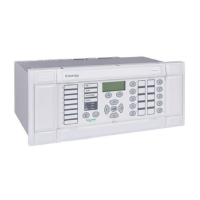Application Notes P54x/EN AP/La4
MiCOM P543, P544, P545 & P546
(AP) 6-59
AP
Note: Dual-end infeed effects will make a fault resistance appear higher,
because each relay cannot measure the current contribution from the
remote line end. The apparent fault resistance increase factor could
be 2 to 8 times the calculated resistance. Therefore it is
recommended that the Zone resistive reaches are set to say, 4 times
the primary arc resistance calculation.
In the example, the minimum phase fault level is 1000 MVA. This is equivalent to an
effective short-circuit fault feeding impedance of:
Z = kV 2/MVA = 2302/1000 = 53 (primary)
The lowest phase fault current level is equivalent to:
Ifault = (MVA x 1000)/(3 x kV)
= (1000 x 1000)/(3 x 230)
= 2.5 kA
And this fault current in the van Warrington formula would give an arc resistance of:
Ra = 4
As this impedance is relatively small compared to the value “Z” calculated above, there is no
need to perform an iterative equation to work out the actual expected Ifault (which would in
reality be lower due to the added Ra arc resistance in the fault loop). It will suffice to
increase the calculated Ra by the recommended factor of four, and a little extra to account
for the fault current being lower than that calculated. So, in this case use a minimum setting
of 5 x Ra, which is 20 primary.
It is obvious that the setting could easily be set above 20 on the primary system (perhaps
following the rule of thumb formula in section 2.3.7). Typically, all zone resistive reaches
woul
d be set greater than this 20 primary figure, and ideally less than the load impedance
(see “load avoidance” section).
3.2.11.2 Ground fault resistive reaches (RGnd)
Fault
resistance would comprise arc-resistance and tower footing resistance. A typical
resistive reach coverage setting would be 40
on the primary system.
For high resistance earth faults, the situation may arise where no distance elements could
operate. In this case it will be necessary to provide supplementary earth fault protection, for
example using the relay Channel Aided DEF protection. In such cases it is not essential to
set large resistive reaches for ground distance, and then RGnd can be set according to the
rule of thumb formula in section 2.3.8.
3.3 Teed feeder protection
The
application of distance relays to three terminal lines is fairly common. However, several
problems arise when applying distance protection to three terminal lines.
3.3.1 The apparent impedance seen by the distance elements
Figure 19 shows a typical three terminal line arran
gement. For a fault at the busbars of
terminal B the impedance seen by a relay at terminal A will be equal to:
Za = Zat + Zbt + [Zbt.(Ic/Ia)]
Relay A will underreach for faults beyond the tee-point with infeed from terminal C. When
terminal C is a relatively strong source, the underreaching effect can be substantial. For a
zone 2 element set to 120% of the protected line, this effect may result in non-operation of
the element for internal faults. This not only effects time delayed zone 2 tripping but also
channel-aided schemes. Where infeed is present, it will be necessary for Zone 2 elements
at all line terminals to overreach both remote terminals with allowance for the effect of tee-
point infeed. Zone 1 elements must be set to underreach the true impedance to the nearest
terminal without infeed. Both these requirements can be met through use of the alternative
setting groups.

